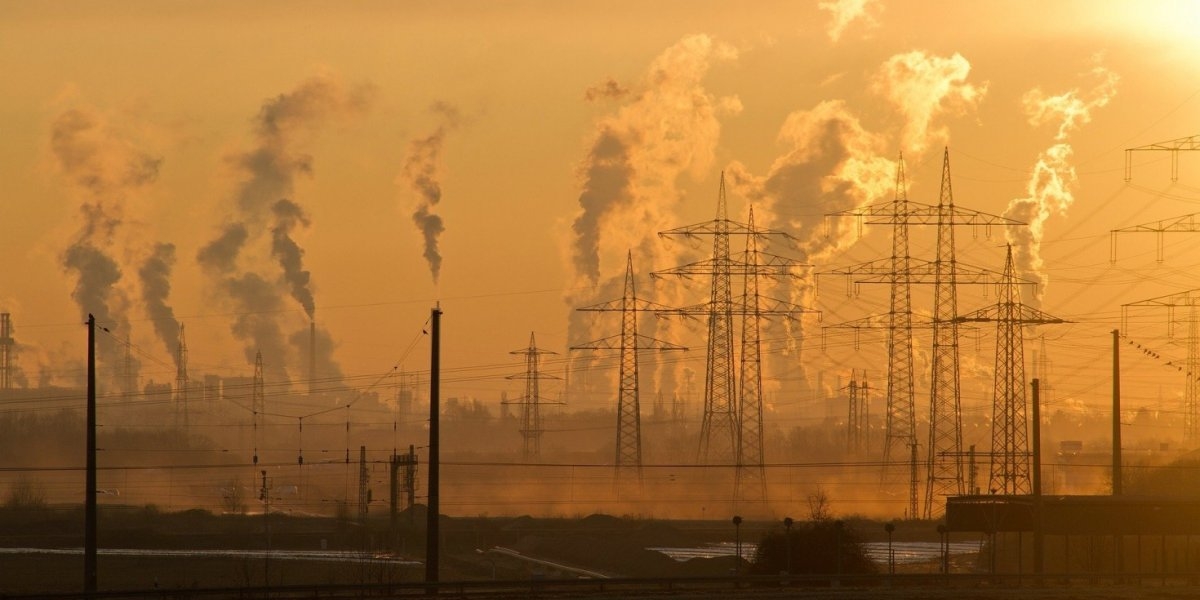Natural gas and oil use push up global co₂ emissions in 2019, according to latest data
Global co₂ emissions are projected to rise a low 0.6% in 2019 due to robust growth in natural gas and oil use, and despite a decline in coal consumption. Natural gas has been the dominant driver of global emissions since 2012.
Today, the Global Carbon Project (GCP) publishes its annual analysis of trends in the global carbon cycle, including the first full-year estimate of the change in global fossil carbon dioxide (CO2) emissions in 2019.
Global fossil CO2 emissions are projected to rise a low 0.6% in 2019 (range: –0.2% to +1.5%) due to sustained growth in the consumption of natural gas and oil, and despite a decline in coal use. A decline in global emissions in 2019 cannot be ruled out given uncertainties in the projection.
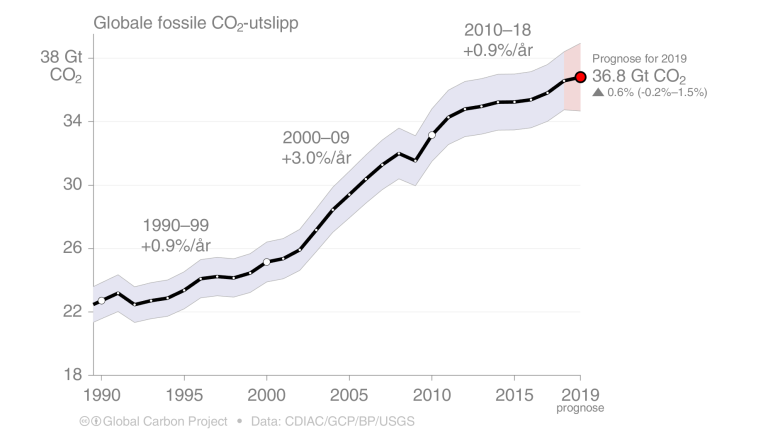
The recent growth in low carbon technologies (solar, wind, electric vehicles) have – at best – only slowed the growth in global fossil fuel emissions. They have also not led to aggressive emission reductions necessary in line with the “well below 2°C” global warming limit set out by the Paris Agreement to avoid the worst impacts of climate change.
“Carbon dioxide emissions must decline sharply if the world is to meet the ‘well below 2°C’ mark set out in the Paris Agreement, and every year with growing emissions makes that target even more difficult to reach,” said Robbie Andrew, a Senior Researcher at the CICERO Center for International Climate Research in Norway.
This year's Global Carbon Budget release includes three papers in the journals Nature Climate Change, Environmental Research Letters, and Earth System Science Data.
Coal declines as natural gas emerges
Global fossil CO2 emissions (fossil fuels, industry and cement) grew by 3% per year in the 2000’s, but growth has slowed since 2010 to an overage of 0.9% per year, and from 2014 to 2016, there was only a very small increase in emissions.
Emissions returned to growth again in 2017 (1.5%), 2018 (2.1%), and now in 2019 (0.6%).
“The weak growth in carbon dioxide emissions in 2019 was due to an unexpected decline in global coal use, but this drop was insufficient to overcome the robust growth in natural gas and oil consumption,” said Glen Peters, Research Director at CICERO.
“Global commitments made in Paris in 2015 to reduce emissions are not yet being matched by proportionate actions,” said Peters.
“Despite political rhetoric and rapid growth in low carbon technologies such as solar and wind power, electric vehicles, and batteries, global fossil CO2 emissions are likely to be more than 4% higher in 2019 than in 2015, when the Paris Agreement was adopted,” he said
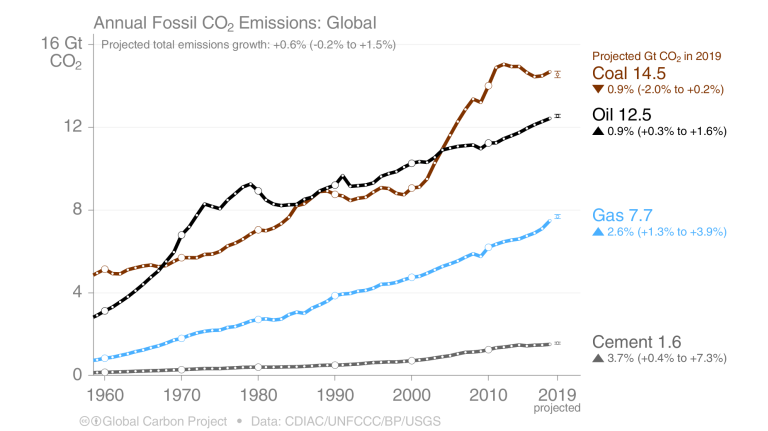
Unexpected decline in coal use
Early estimates suggest that CO2 emissions from coal use will decline by –0.9% in 2019 (range: –2.0% to +0.2%), while CO2 emissions from oil consumption will grow 0.9% (range: +0.3% to +1.6%) and natural gas 2.6% (range: +1.3% to +3.9%).
“Through most of 2019 it was looking as if coal use would grow globally, but weaker than expected economic performance in China and India, and a record hydropower year in India – caused by a strong monsoon – quickly changed the prospects for growth in coal use,” said Andrew.
“Coal use in both the US and the EU28 has dropped substantially, possibly by as much as 10% in both regions in 2019 alone, helping push down global coal consumption”, Andrew said.
While the world has been watching the ups and downs of global coal use, oil and natural gas consumption continues to grow strongly, with gas experiencing the strongest growth.
“Compared to coal, natural gas is a cleaner fossil fuel, but unabated natural gas use merely cooks the planet more slowly than coal,” said Peters.
“While there may be some short-term emissions reductions from using natural gas instead of coal, natural gas consumption needs to be phased out quickly to meet ambitious climate goals,” he said.
US and EU28 emissions decline
Almost all countries have contributed to the rise in global emissions; either by growth in emissions or reductions that are slower than required.
US emissions have declined at 1.1% per year since the peak in 2005, and that trend continues in 2019 with a decrease of –1.7% (range: –3.7% to 0.3%), offsetting a weather-related increase in emissions in 2018, which drove up demand for heating in cold months and for cooling in hot months.
The US emissions decrease in 2019 has been driven by a 10% drop in emissions from coal use, with coal being replaced by cheap gas, wind, and solar. CO2 emissions from the decline in coal (–10%) and oil use (–0.5%) were partly offset by increases in natural gas consumption (3.5%).
Emissions in the EU28 have fallen steadily by –1.4% per year in the last decade, and are projected to decrease by –1.7% in 2019 (range: –3.4% to +0.1%).
Despite the expected decline in coal use of around 10%, growth in the consumption of oil and natural gas will make the emissions reduction rate lower than in 2018 (–2.1%).
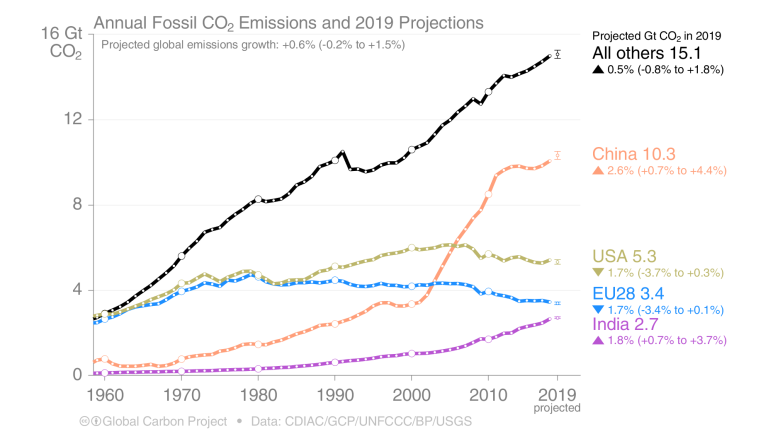
Chinese and Indian emissions growth
China had low growth and unexpected declines in CO2 emissions over the period 2014 to 2016, but in 2017 and 2018 CO2 emissions rose again by 1.7% and 2.3%, respectively.
In 2019, China’s CO2 emissions are expected to rise by 2.6% (range +0.7% to +4.4%). Chinese emissions might have grown faster if China had not been experiencing slower economic development and weaker growth in electricity demand.
“There was hope that China's use of coal was on a robust downward trend, but coal consumption in the country continues to grow, albeit modestly”, said Jan Ivar Korsbakken, Senior Researcher at CICERO.
“China uses half of all coal in the world, and coal looks set to stay the biggest source of both energy and CO2 emissions in China for many years to come,” Korsbakken added.
China has seen low growth in electricity demand so far in 2019, and no growth in coal-fired electricity generation, as an increase in power production from renewables and nuclear plants has been able to meet most of the demand growth.
But stronger growth in the production of steel, cement and other coal-intensive industrial products has kept coal consumption afloat. Oil and gas use continue to grow rapidly, and together they now contribute more to emissions growth in China than coal.
Indian CO2 emissions have grown at 5.1% per year over the last decade, but growth is expected to be much weaker in 2019 at 1.8% (range: +0.7% to +3.7%). Weak economic growth in India has led to slower growth in oil and natural gas use.
With a weakening economy, growth in India’s generation of electricity has slowed from 6% per year in the period 2016-2018 to under 1% in 2019, despite electrification of villages adding to potential demand. Moreover, the addition of a very wet monsoon boosted hydro power generation and resulted in a decline in generation from coal.
Emissions in the rest of the world – the remaining 42% of global emissions – are expected to grow about 0.5% in 2019 (range –0.8% to +1.8%), much lower than in the previous decade.
Continued growth in emissions drives increases in atmospheric concentrations
Global carbon dioxide emissions from fossil fuels and industry will reach around 36.8 billion tonnes in 2019, a record high. Preliminary estimates of land-use change for 2019 suggest a value of 6 billion tonnes of CO2, which is 0.8 billion tonnes higher than in 2018 due to an increase in forest fires.
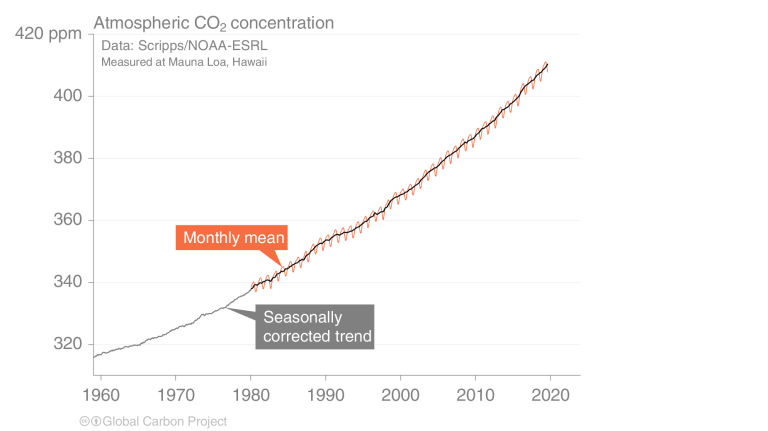
Meanwhile, global CO2 emissions from all human activities (fossil fuels, industry, and land-use change) are expected to reach 43.1 billion tonnes in 2019 (range: 39.9 to 46.2 billion tonnes).
Atmospheric CO2 concentration reached 407.4 parts per million in 2018 on average and is projected to increase by 2.2 ppm in 2019 (+1.8 to +2.6ppm) to reach about 410 ppm. This increase is near the average of the past decade because of the return to El Niño neutral conditions, but above previous decades due to rising CO2 emissions.
References
Friedlingstein et al. (2019) Global Carbon Budget 2019. Earth System Science Data. Peters G.P., R.M. Andrew, J.G. Canadell, P. Friedlingstein, R.B. Jackson, J.I. Korsbakken, C. Le Quéré, and A. Peregon (2019). Carbon dioxide emissions continue to grow amidst slowly emerging climate policies. Nature Climate Change. Jackson, R.B., P. Friedlingstein, R. M. Andrew, J.G. Canadell, C. Le Quéré, G.P. Peters (2019). Persistent Fossil Fuel Emissions Threaten the Paris Agreement and Planetary Health, Environmental Research Letters.
